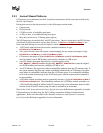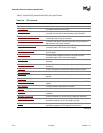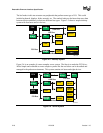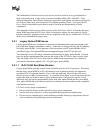
Overview
Version 1.10 12/01/02 2-11
2.3.3 Itanium
®
-Based Platforms
EFI executes as an extension to the SAL execution environment with the same rules as laid out by
the SAL specification.
During boot services time the processor is in the following execution mode:
• Uniprocessor
• Physical mode
• 128 KB, or more, of available stack space
• 16 KB, or more, of available backing store space
• May only use the lower 32 floating point registers
The EFI Image may invoke both SAL and EFI procedures. Once in virtual mode, the EFI OS must
switch back to physical mode to call any boot services. If SetVirtualAddressMap()
has
been used, then runtime service calls are made in virtual mode.
• ACPI Tables loaded at boot time must be contained in memory of type
EfiACPIReclaimMemory.
• The system firmware must not request a virtual mapping for any memory descriptor of type
EfiACPIReclaimMemory or EfiACPIMemoryNVS.
• EFI memory descriptors of type EfiACPIReclaimMemory and EfiACPIMemoryNVS
must be aligned on an 8 KB boundary and must be a multiple of 8 KB in size.
• Any EFI memory descriptor that requests a virtual mapping via the
EFI_MEMORY_DESCRIPTOR having the EFI_MEMORY_RUNTIME bit set must be aligned
on a 8 KB boundary and must be a multiple of 8 KB in size.
• An ACPI Memory Op-region must inherit cacheability attributes from the EFI memory map. If
the system memory map does not contain cacheability attributes the ACPI Memory Op-region
must inherit its cacheability attributes from the ACPI name space. If no cacheability attributes
exist in the system memory map or the ACPI name space, then the region must be assumed to
be noncacheable.
• ACPI tables loaded at runtime must be contained in memory of type EfiACPIMemoryNVS or
EfiFirmareReserved. The cacheability attributes for ACPI tables loaded at runtime (via
ACPI LoadTable) should be defined in the EFI memory map. If no information about the table
location exists in the EFI memory map, the table is assumed to be noncached.
Refer to the IA-64 System Abstraction Layer Specification (see the References appendix) for details.
EFI procedures are invoked using the P64 C calling conventions defined for Itanium-based
applications. Refer to the document 64 Bit Runtime Architecture and Software Conventions
for IA-64 (see the References appendix) for more information.


















